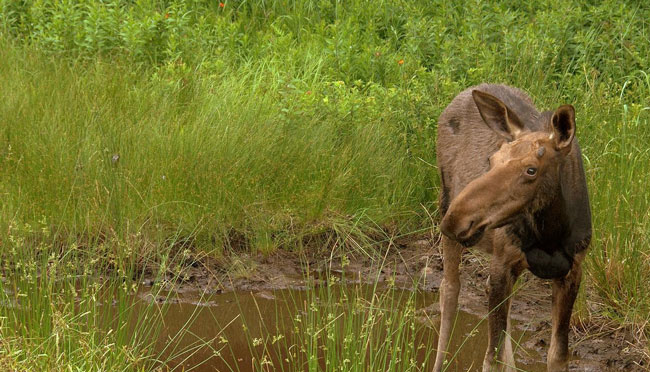Ticks Are a Factor in the Decline of New Hampshire Moose
By Chris Williams on August 16, 2013.

Here’s an amazing fact. In 1950, there were just 50 moose in the entire state of New Hampshire. Five years ago, there were almost 8,000. Today there are less than 5,000 moose in New Hampshire and they are in big trouble thanks in large part to ticks. Blood-sucking ticks are literally draining the moose dry, killing them in droves.
The scourge for the moose are winter ticks that hatch out in the fall and feed on the moose until the end of May. Estimates are that a single moose can host up to 150,000 blood-sucking ticks; the average per moose is 32,000 ticks. Moose have been dying by the thousands in New Hampshire. Those that survive the tick onslaught are thin with ribs showing, and large areas of hair loss on their bodies.
Winter Tick Survival is the Problem
Winter ticks are a different species than the deer or dog ticks that feed on us and our pets. Winter ticks are a single-host tick that feed on one animal for their entire lifetime. That’s bad news for the moose because the ticks have a longer lifetime now than they used to—blame it on climate change. Used to be that New Hampshire’s cold winters killed a lot of winter ticks and their eggs. The ticks and the moose maintained an equilibrium. Winters are reliably shorter now; ticks don’t die anymore. When New Hampshire has a short winter that allows ticks to survive, almost none of the moose calves survive that year and only 25% of adults. Maine, where cold winters still exist, is the only state where moose populations are increasing.
It’s not just New Hampshire. Moose are dying off dramatically in Minnesota, Montana, Wyoming, other parts of the Rocky Mountains, and in a section of North Dakota. Minnesota has had the most serious decline, starting in the late 1990s. In just one year, 2012-2013, one part of Minnesota lost 35% of its moose population. Scientists believe it can’t all be blamed on ticks, but they’re having a difficult time trying to tie all the factors together. They’re looking at a brain worm parasite, mosquito-related viruses, and fungal disease. If moose are already compromised health-wise, the resulting anemia, secondary bite infections, and stress-related starvation from so many feeding ticks can be enough to put them over the edge.
The decline of the moose population will affect many other parts of the state’s ecosystem. The lumbering moose clear brush and create spaces where smaller animals can hide from predators. Moose also provide food for coyotes and bears. The decline will affect New Hampshire’s economy as well since “moose watching” wildlife tours generate $115 million annually.
New Hampshire has launched a $695,000 four-year study of its moose population. The results of the study will help the state manage the moose population by adjusting the number of hunting permits issued. “A study can identify the threat to the moose population but not necessarily stop it,” said Kristine Rines, moose project leader for the Fish and Game Department. What the moose population needs is a good, old-fashioned Arctic winter to break the tick cycle. The odds of that happening every few years, like it used to, are getting slimmer.
[Sources: D.Fears. The Washington Post, Aug. 10, 2013; A. Timmins. Concord Monitor, July 28, 2013]
Photo credit: numb – Up All Night to Get Lucky / Foter / CC BY-NC-ND